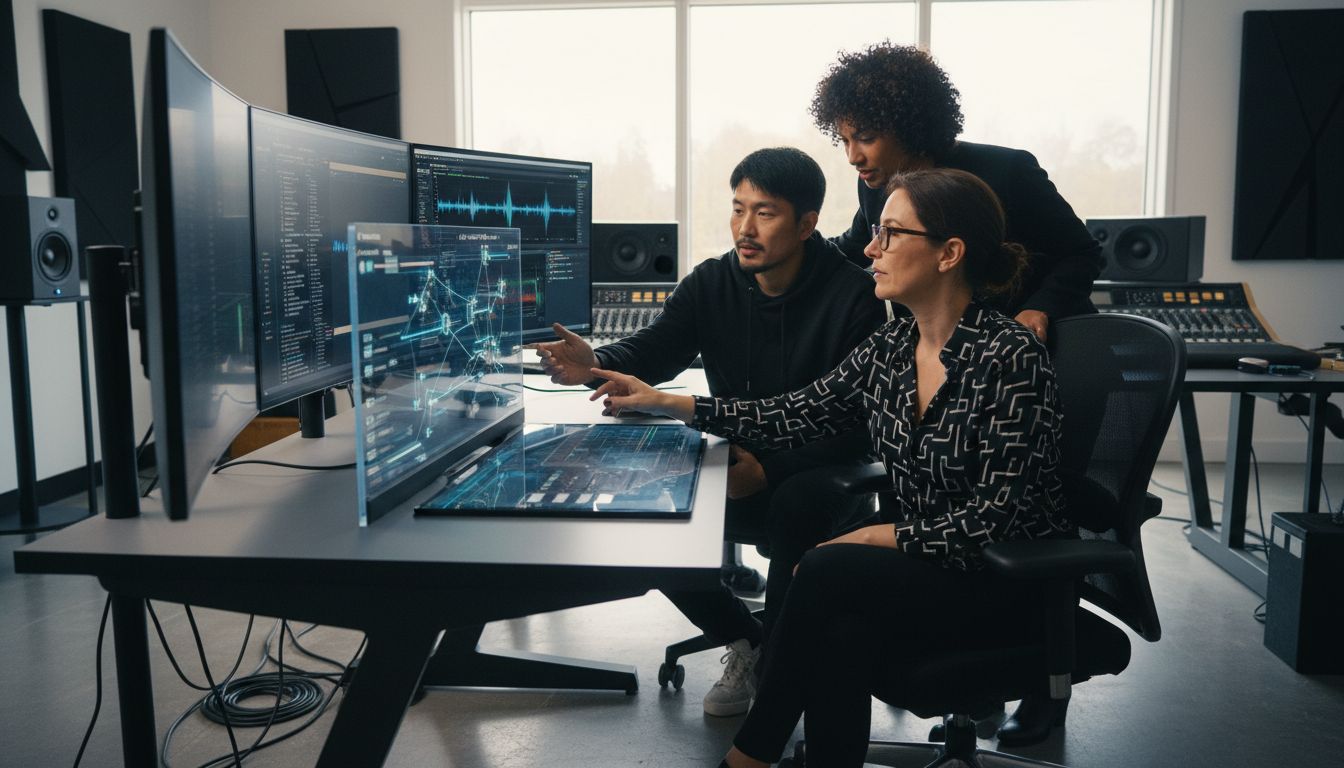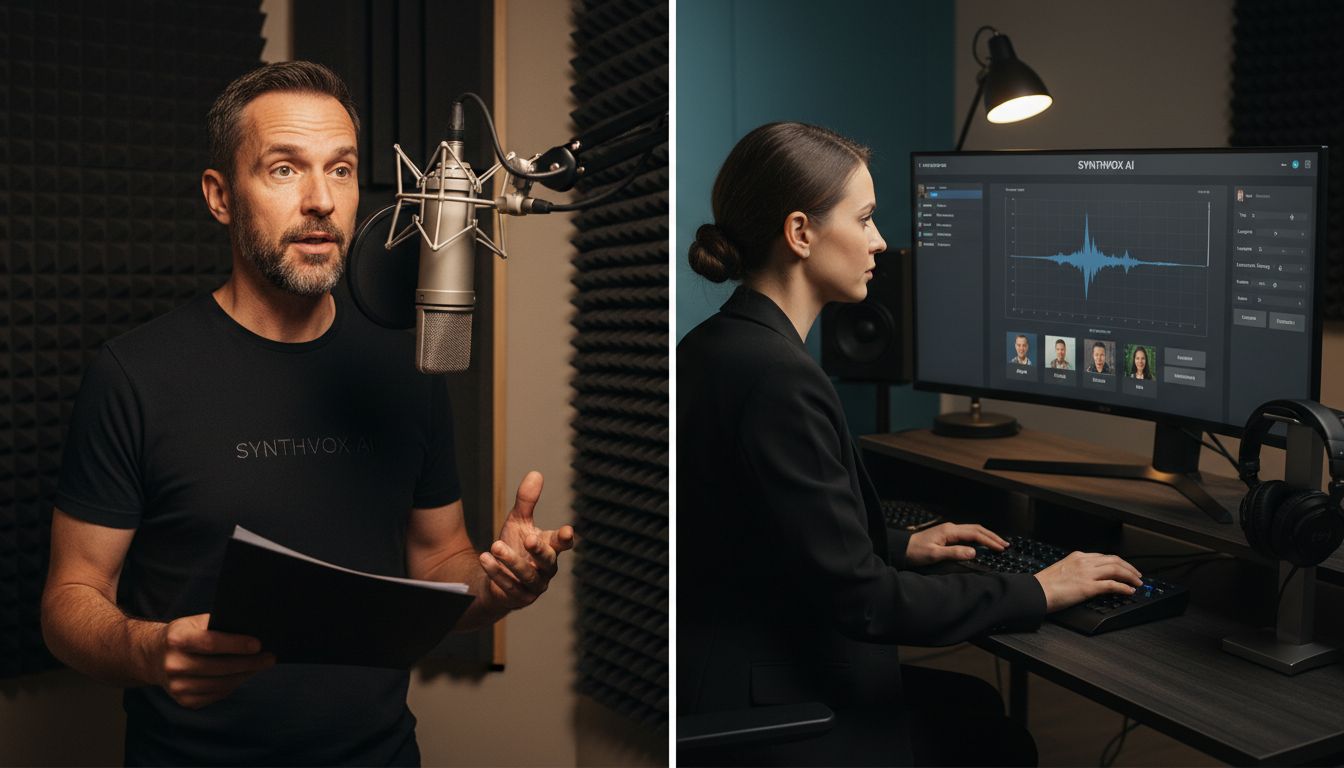What Is AI Voiceover? Everything You Need to Know
Comprehensive guide on AI voiceover: definitions, key features, types, use cases, benefits, risks, and practical tips for creators and teams.
Aniket
Author
What Is AI Voiceover? Everything You Need to Know

Nearly 80 percent of people say they cannot tell the difference between AI-generated and human voices. This rapid progress sparks curiosity and concern about what truly powers these lifelike sounds. As AI voiceover technologies reshape content creation, learning the realities behind the process and the myths that surround it can help creators and listeners better understand their options for more natural, accessible, and versatile audio experiences.
Table of Contents
Key Takeaways
| Point | Details |
|---|---|
| AI Voiceover Technology | Leverages machine learning to create human-like audio without human speech recording, augmenting creative possibilities. |
| Main Technologies | Includes concatenative, parametric, neural network, and WaveNet synthesis for varying levels of voice realism and application. |
| Applications Across Industries | Utilized in entertainment, accessibility, customer service, education, and healthcare for personalized audio experiences. |
| Choosing Tools | Evaluate voice quality, language support, customization, integration capabilities, and technical specifications for effective tool selection. |
Defining AI Voiceover and Common Myths
- Defining AI Voiceover and Common Myths
- Types of AI Voiceover Technologies Explained
- How AI Voiceover Works: Process and Features
- Top Applications and Real-World Use Cases
- Key Benefits, Challenges, and Limitations
- Choosing AI Voiceover Tools: What to Consider
AI voiceover represents an innovative technology that leverages artificial intelligence to generate human-like vocal audio without requiring direct human speech recording. According to research from DeepMind, deep neural networks can now synthesize remarkably realistic voices by training on extensive human speech recordings.
The core mechanism behind AI voiceover involves complex machine learning algorithms that analyze speech patterns, vocal characteristics, and linguistic nuances. As demonstrated in generative artificial intelligence research, these systems can now produce audio that sounds strikingly similar to natural human speech. Key capabilities include:
- Generating multiple voice personas
- Adjusting tone and emotional inflection
- Supporting multiple language translations
- Producing consistent vocal quality
Contrary to popular misconceptions, AI voiceover isn't about replacing human voice actors but augmenting creative possibilities. Understanding the role of AI in content creation reveals that these technologies are collaborative tools designed to enhance productivity and accessibility. While some fear AI might eliminate jobs, the technology actually opens new opportunities for personalized audio experiences across industries like entertainment, education, and accessibility support.

Types of AI Voiceover Technologies Explained
AI voiceover technologies have rapidly evolved into sophisticated systems with multiple distinct approaches. Deep neural network models represent the most advanced current implementation, enabling unprecedented voice synthesis capabilities. According to research from the Deep Voice project, these technologies now comprise complex multi-component systems that can transform text into remarkably natural speech.
The primary categories of AI voiceover technologies include:
Here's a summary of common AI voiceover technologies:
| Technology Type | Description | Key Strength |
|---|---|---|
| Concatenative Synthesis | Uses pre-recorded audio segments | Consistent output |
| Parametric Synthesis | Generates speech via statistical models | Flexible voice adjustment |
| Neural Network Synthesis | Deep learning for human-like voices | Highly realistic sound |
| Wavenet Models | Produces raw audio waveforms | High fidelity, naturalness |
- Concatenative Synthesis: Stitching pre-recorded speech segments
- Parametric Synthesis: Generating speech using statistical models
- Neural Network Synthesis: Using deep learning to create human-like voices
- Wavenet Models: Generating raw audio waveforms with high fidelity
Research from Deep Voice 3 demonstrates that modern neural text-to-speech systems can now process extensive audio datasets spanning hundreds of hours and thousands of speakers. Understanding features of modern video tools reveals how these technologies are transforming content creation, enabling more personalized and adaptive audio experiences across multiple industries. The technology continues to advance, promising even more nuanced and contextually aware voice generation in the near future.
How AI Voiceover Works: Process and Features
AI voiceover technology transforms text into lifelike speech through a complex, multi-stage neural network process. According to research from the Deep Voice project, this sophisticated system breaks down voice generation into precise computational steps, each designed to mimic human vocal production with remarkable accuracy.
The core process involves several critical stages:
- Text Processing: Converting written text into phonetic representations
- Linguistic Analysis: Identifying speech patterns and contextual nuances
- Speech Synthesis: Generating audio waveforms that sound natural
- Voice Modulation: Adjusting tone, pitch, and emotional characteristics
Research from Deep Voice 3 highlights the advanced attention-based neural network mechanism, which uses convolutional layers to align text and speech features dynamically. 7 practical examples of AI tools for productivity gains demonstrates how these technologies are revolutionizing content creation by enabling rapid, high-quality audio generation across multiple contexts. The technology continues to evolve, promising even more sophisticated and contextually intelligent voice synthesis in the future.
Top Applications and Real-World Use Cases
AI voiceover technology has rapidly expanded across multiple industries, transforming how we interact with digital content and communication systems. According to research on audio deepfake technologies, these innovative solutions are creating remarkable opportunities for personalized and accessible communication.
Key applications span diverse sectors:
- Entertainment: Generating audiobooks and dubbing content
- Accessibility: Helping individuals with speech disabilities
- Customer Service: Creating natural-sounding virtual assistants
- Education: Producing multilingual learning materials
- Healthcare: Supporting patient communication and medical training
Generative AI technologies like WaveNet have been particularly revolutionary in developing realistic human-like voices. Understanding productivity with AI video technology highlights how these tools are not just technological novelties, but powerful instruments for enhancing communication, breaking language barriers, and creating more inclusive digital experiences. The potential continues to grow, promising even more sophisticated and nuanced voice generation capabilities in the near future.
Key Benefits, Challenges, and Limitations
AI voiceover technology presents a complex landscape of remarkable opportunities and significant challenges. According to research, these tools offer unprecedented efficiency, achieving up to 90-95% naturalness in voice reproduction while simultaneously raising critical ethical considerations about technological authenticity.
The key benefits and challenges include:
- Cost Efficiency: Rapid, affordable content production
- Scalability: Instant voice generation across multiple languages
- Accessibility: Supporting individuals with speech limitations
- Ethical Concerns: Potential for voice impersonation and misuse
- Technical Limitations: Reduced emotional nuance compared to human performers
Research on audio deepfake technologies highlights the double-edged nature of these innovations. 7 effective examples of AI collaboration tools demonstrates how these technologies are pushing boundaries while simultaneously requiring robust ethical frameworks. The future of AI voiceover will likely depend on balancing technological advancement with responsible implementation, ensuring these powerful tools enhance rather than compromise human communication.
Choosing AI Voiceover Tools: What to Consider
Selecting the right AI voiceover tool requires careful evaluation of multiple critical factors. According to research in AI voice generation, the selection process goes beyond simple feature comparison and demands a strategic approach to matching technological capabilities with specific project needs.
Key considerations for choosing an AI voiceover tool include:
- Voice Quality: Naturalness and human-like speech characteristics
- Language Support: Range of available languages and accents
- Customization Options: Ability to adjust pitch, speed, and emotional tone
- Integration Capabilities: Seamless workflow compatibility
- Technical Specifications: Audio output format and processing speed
Master an easy video scripting workflow today emphasizes the importance of selecting tools that not only generate high-quality voiceovers but also integrate smoothly into existing content creation processes. The ideal AI voiceover tool should balance technological sophistication with user-friendly design, enabling creators to produce professional-grade audio content efficiently and effectively.
Transform Your Content with AI Voiceover and Async Video
Struggling to harness the power of AI voiceover technology while managing tight schedules and collaboration hurdles? This article highlights the challenges of producing natural, engaging voice content and the need for quick, scalable solutions that fit modern workflows. Whether it is achieving seamless multilingual dubbing, perfect voice modulation, or overcoming the costly and time-consuming nature of traditional voiceover methods, the demand for smarter tools is clear.
Boom offers a powerful solution that aligns perfectly with these goals. With features like AI Voiceover & Multilingual Dubbing, Auto-scripting for instant script creation, and an async-first design, Boom empowers freelancers, marketers, and teams to create flawless, on-brand videos without endless meetings or complicated setups. This means you can focus on your message while Boom handles the voice, video timing, and branding seamlessly.
Looking to save hours and elevate your voice content to the next level? Discover how Boom's AI voiceover transforms your workflow.

See how you can create, speak, and share stunning videos on your own time with Boom. Explore 7 practical examples of AI tools for productivity gains to maximize efficiency and learn how to master an easy video scripting workflow today. Visit Boom’s homepage now and start earning your time back.
Frequently Asked Questions
What is AI voiceover technology?
AI voiceover technology uses artificial intelligence to create human-like vocal audio from written text without needing human voice recordings. It leverages machine learning algorithms and deep neural networks to synthesize realistic speech.
How does AI voiceover work?
AI voiceover works by processing text into phonetic representations, performing linguistic analysis to understand context, generating audio waveforms, and modulating voice characteristics such as tone and pitch. This multi-stage process ensures a natural-sounding voice output.
What are the main types of AI voiceover technologies?
The main types of AI voiceover technologies include Concatenative Synthesis, which stitches pre-recorded audio segments; Parametric Synthesis, which uses statistical models; Neural Network Synthesis, which relies on deep learning; and Wavenet Models, which generate high-fidelity audio waveforms.
What are the benefits and challenges of using AI voiceover?
The benefits of AI voiceover include cost efficiency, scalability for multiple languages, and accessibility for individuals with speech disabilities. However, challenges include ethical concerns such as potential voice impersonation and the technical limitations of reduced emotional nuance compared to human performers.
Recommended
About the Author
Aniket
Software Engineer.
